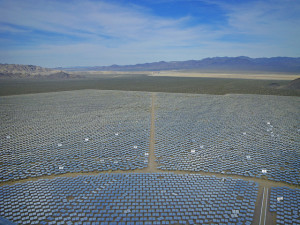
Ivanpah solar energy facility, California
(This is the second installment in a series about differences between Democratic and Republican Presidents in areas where they have direct control. See our Democratic vs. Republican Presidents category for the rest.)
In June 1979, Democratic U.S. President Jimmy Carter had 32 solar panels installed on the roof of the White House, for water heating. By 1986, Republican President Ronald Reagan had the panels removed, and also:
gutted the research and development budgets for renewable energy at the then-fledgling U.S. Department of Energy (DoE) and eliminated tax breaks for the deployment of wind turbines and solar technologies—recommitting the nation to reliance on cheap but polluting fossil fuels, often from foreign suppliers.
This see-sawing between Republican and Democratic presidents on energy policy continues today. It’s fair to say that Republican presidents never saw a fossil fuel they didn’t like, while Democratic presidents have made efforts toward conservation and the development and use of clean, renewable energy.
For example, Republican President George W. Bush, Texas son of an oil man, was an oil-loving president. First, there was the infamous Energy Task Force chaired by Vice President Dick Cheney. Created just nine days into Bush’s presidency, the Task Force held secret meetings with lobbyists and executives from the oil, gas and mining industries, some of whom were friends and cronies of Bush and Cheney, such as Enron President and Chairman Kenneth Lay and Eli Bebout, an old Cheney friend who was also a Wyoming state senator and owner of an oil drilling company.
Not surprisingly, the Cheney Energy Task Force came up with fossil fuel-friendly policies that the Bush administration adopted, including efforts to allow drilling in the Arctic National Wildlife Refuge (ANWR). And ironically, the result of Bush’s energy policy was America remaining well over 50 percent dependent on foreign oil.
Then there was Bush’s Iraq War, which many parties on both sides alleged was fought at least in part for oil rather than Bush’s stated reasons such as “terrorism” and “weapons of mass destruction.” It didn’t help when both Bush Deputy Defense Secretary Paul Wolfowitz and White House Press Secretary Ari Fleischer said that Iraq could pay for its own war reconstruction with its oil revenues. Presumably that meant that the U.S. could take such revenues, or Iraq’s oil resources, by force. Not only did these Iraq War oil pipe dreams fail to materialize, the U.S. military during the Iraq War became the largest user of oil on the planet.
Democratic President Barack Obama has taken a different path. Obama describes his energy policy as “all of the above,” meaning that he wants to use all the different sources of American energy. While environmentalists are not happy about Obama’s approval of increased oil and gas drilling (including natural gas fracking), the Obama administration has also promoted and approved numerous renewable energy projects. This includes dozens of solar, wind and geothermal energy projects on public lands. As a result, U.S. renewable energy use has increased to the highest rates ever, and U.S. electricity use is decreasing relative to the rate of our population growth. At the same time, President Obama has evolved from a candidate touting “clean coal” in 2008 to one who Republicans now say is waging a “war on coal.” Indeed, the U.S. share of energy generated from coal has dropped markedly under President Obama.
President Obama has also raised fuel efficiency standards for cars and trucks, which saves oil. Likewise, the Obama administration has delayed its decision on the Keystone XL pipeline, and vetoed a bill that would have let Congress approve the pipeline. Democratic presidential hopefuls including Hillary Clinton, Martin O’Malley and Bernie Sanders all oppose Keystone XL. In contrast, Republican contenders such as John Ellis Bush and Lindsey Graham favor Keystone XL. Even the U.S. military is going green under President Obama. Moreover, the Obama administration in recent days canceled two scheduled lease sales for offshore oil drilling in the Arctic region in 2016 and 2017.
In the future, whatever growth we have achieved in renewable energy is much more likely to be halted under a Republican president, who will have incentives to take us back to dirty fossil fuels. Oh, and those solar panels that Ronald Reagan removed from the White House roof? Barack Obama put them back.
Photo by USFWS Pacific Southwest Region, used under Creative Commons license. http://is.gd/eJbde6


